MARIANI’S
Virtual Gourmet
October
13, 2018
NEWSLETTER
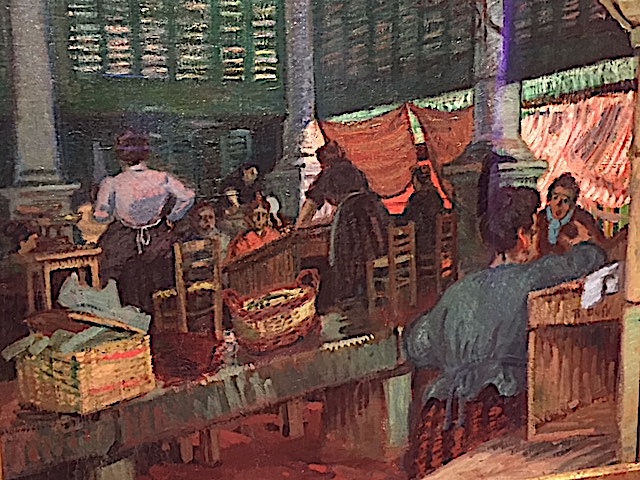
❖❖❖
IN THIS ISSUE
EATING AROUND PHILLY,
Part Two
By John Mariani
NEW YORK CORNER
BABU JI
By John Mariani
NOTES FROM THE WINE CELLAR
THE MUCH IMPROVED BUBBLIES
FROM FRANCIACORTA
By Geoff Kalish
❖❖❖
EATING AROUND PHILLY,
Part Two
By John Mariani
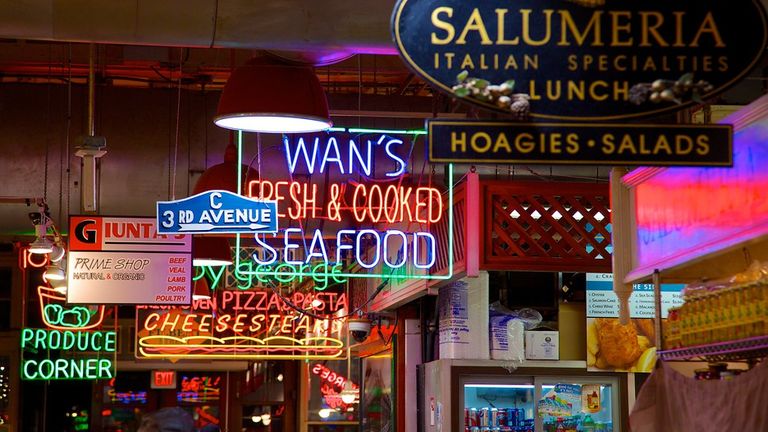
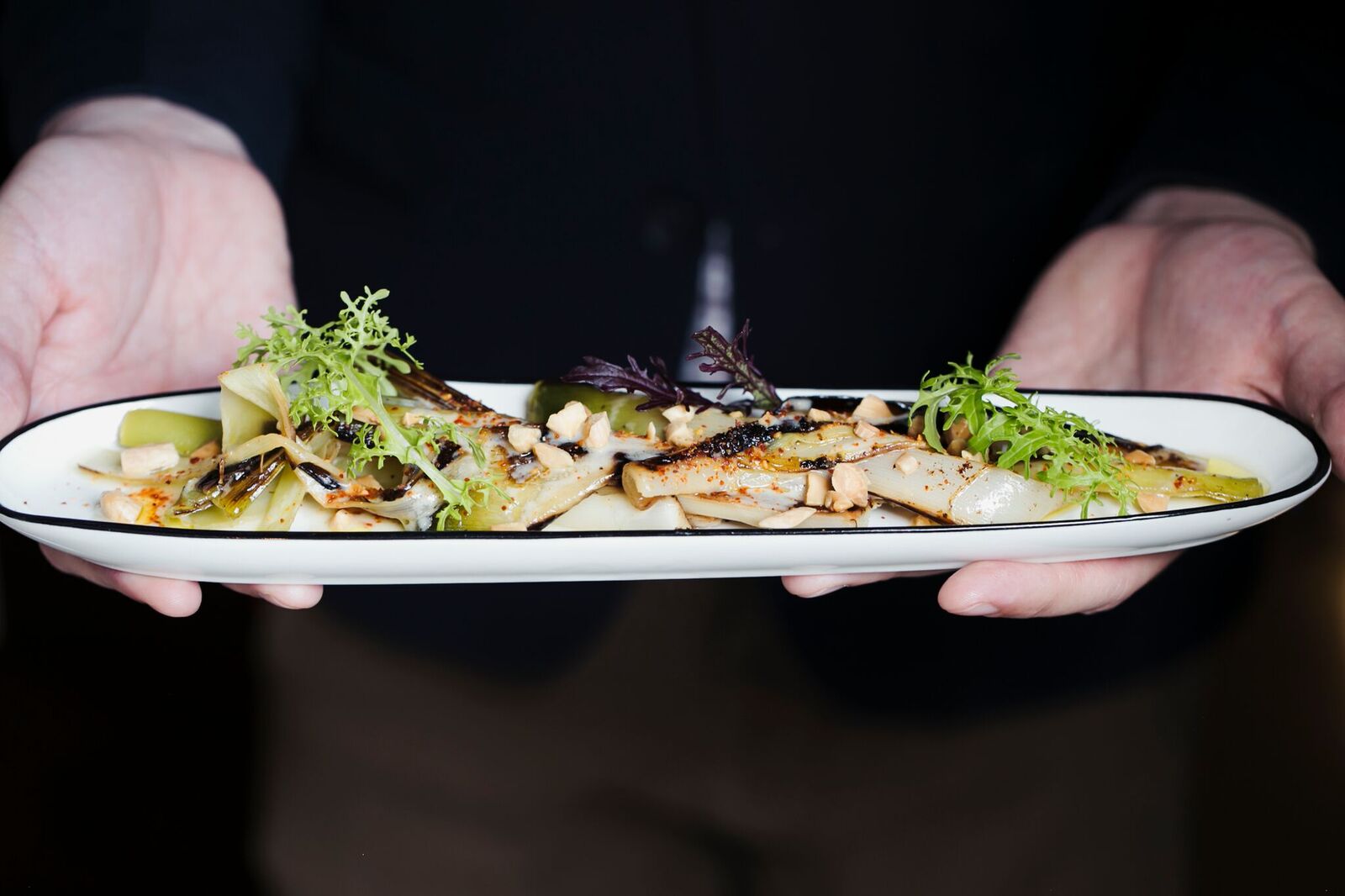 a.kitchen
a.kitchen
135 South 18th Street
215-825-7030
Opened
in 2011 in the AKA
Rittenhouse Square Hotel, a.kitchen
(with a.bar next door) is Ellen Yin’s fourth
restaurant (one is in Manhattan), and I’ve admired
her handiwork since she was at the still-popular
Fork. The unappealing name in lowercase does
nothing to indicate what a fine contemporary
restaurant this is, without anything gimmicky on
the menu, and everything that’s there is wrought
with intense flavors, via Chef Eli Collins. 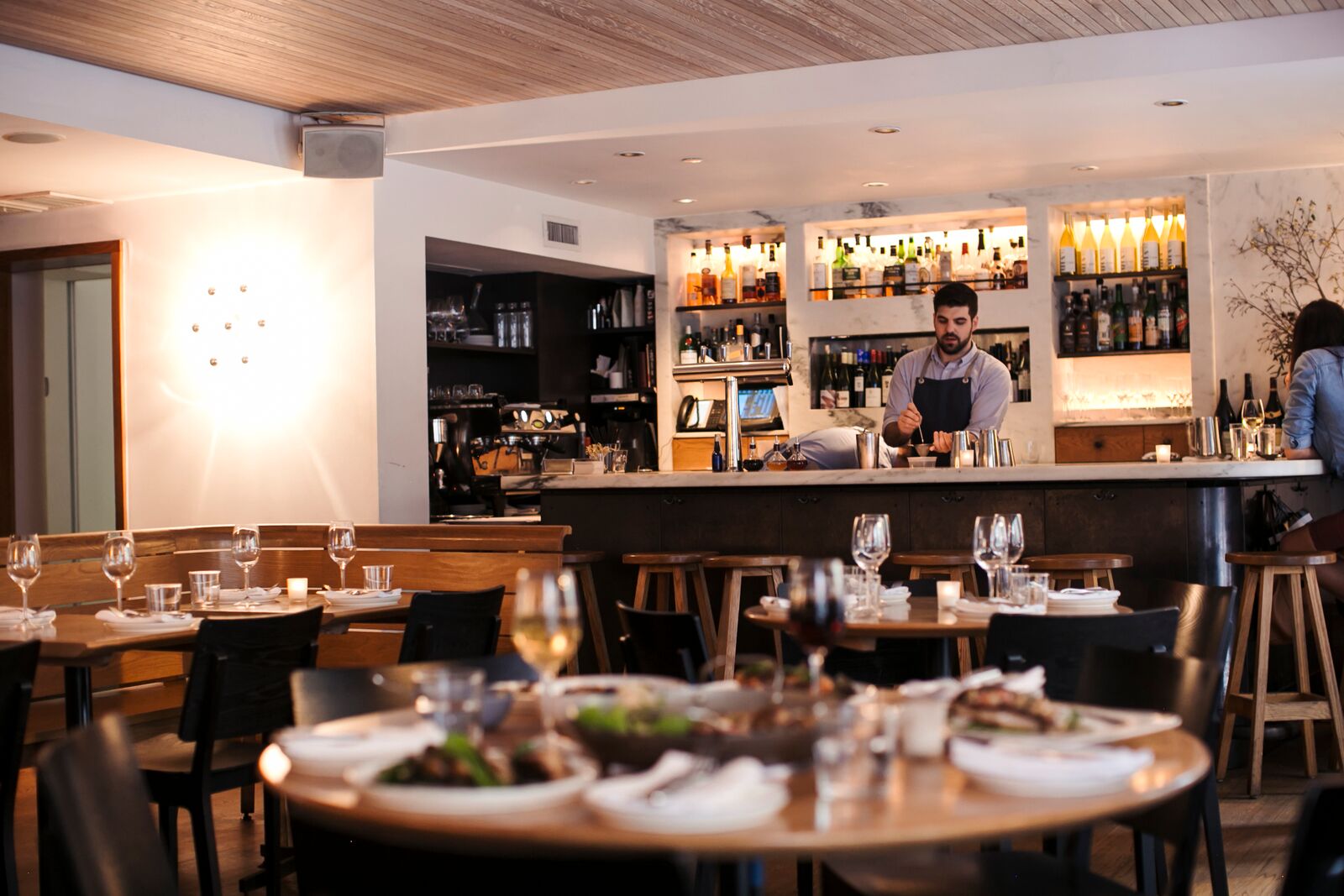
The room, opening onto the street, is a stylistic
combination of white marble and black steel, with
white oak to soften the ambiance. There is counter
seating in front of the open kitchen.
Ours was a table for six, an ideal number to allow
people to share the generous portions, beginning
with the charcuterie ($18) of chicken liver
mousse, corned lamb terrine, and pork and olive
rillette. Adding
a buttermilk Ranch-style dressing to cucumbers and
kohlrabi with rhubarb and chili honey ($13) makes
all the difference in flavors, while the cheese
selection ($16) is composed of varieties you
rarely see anywhere.
Informed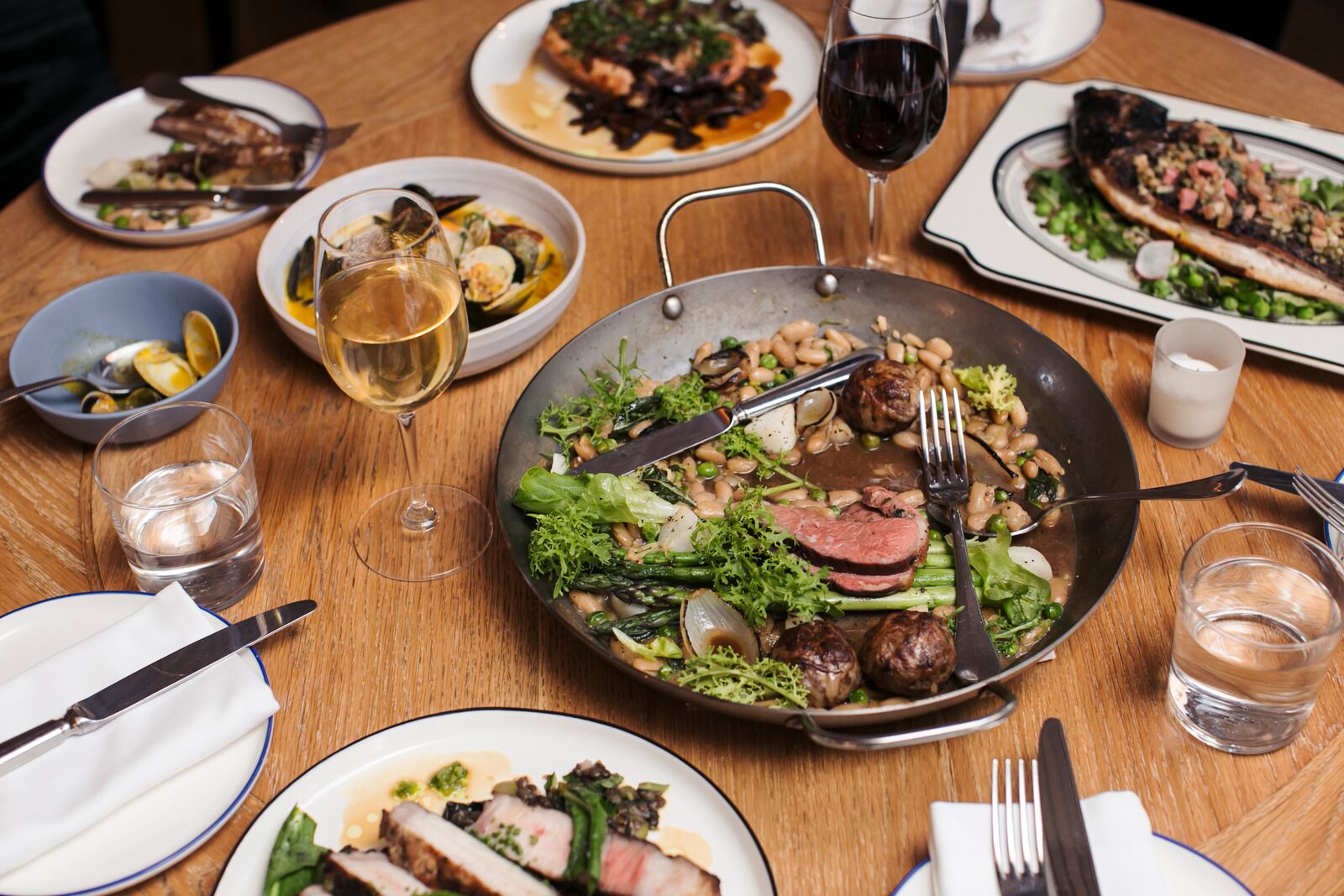 that the
burger was really worth trying, I found the ample
but not over-stuffed patty of excellent ground
beef with American cheese, a sprightly Dijonnaise
mayo and good roll ($18) a winning combination,
and the veal flank steak ($22) with baby lettuces
and assertive salsa verde
made for a hefty lunch item. Of course, it’s
always satisfying when you find that a chef really
knows how to grill a whole fish so that its
exterior has a slight char and the interior is
wholly moist and sweet ($24).
that the
burger was really worth trying, I found the ample
but not over-stuffed patty of excellent ground
beef with American cheese, a sprightly Dijonnaise
mayo and good roll ($18) a winning combination,
and the veal flank steak ($22) with baby lettuces
and assertive salsa verde
made for a hefty lunch item. Of course, it’s
always satisfying when you find that a chef really
knows how to grill a whole fish so that its
exterior has a slight char and the interior is
wholly moist and sweet ($24).
Desserts are outstanding, from a Basque pistachio
cake ($8) and chocolate hazelnut Paris-Brest ($12)
to a light, pretty verbena cream and strawberry
confection ($8).
The
wines by the glass are well chosen.
Open for breakfast and lunch
Mon.-Fri., for brunch Sat. & Sun., for
dinner nightly.
THE LOVE
130 South 18th Street
215-433-1555
How
such a wonderful restaurant can have such a silly
name is beyond me, but all is forgiven when you
enter this 100-seat restaurant with communal
tables, located near Rittenhouse Square. (It can
get loud, so try to snag a table near the front
door.)
This is one of Stephen Starr’s newest creations
and one of his most straightforward—no huge
statues of Buddha, no gilded bicycles or homages
to Mexican wrestlers, no purple alcoves. It’s an
American eatery with Starr’s signature hospitality
and one of Philadelphia’s most respected chefs,
Aimée Olexy (below),
who is also at Talula’s Garden and Talula’s Table,
where she features a very popular 12-person
tasting dinner.
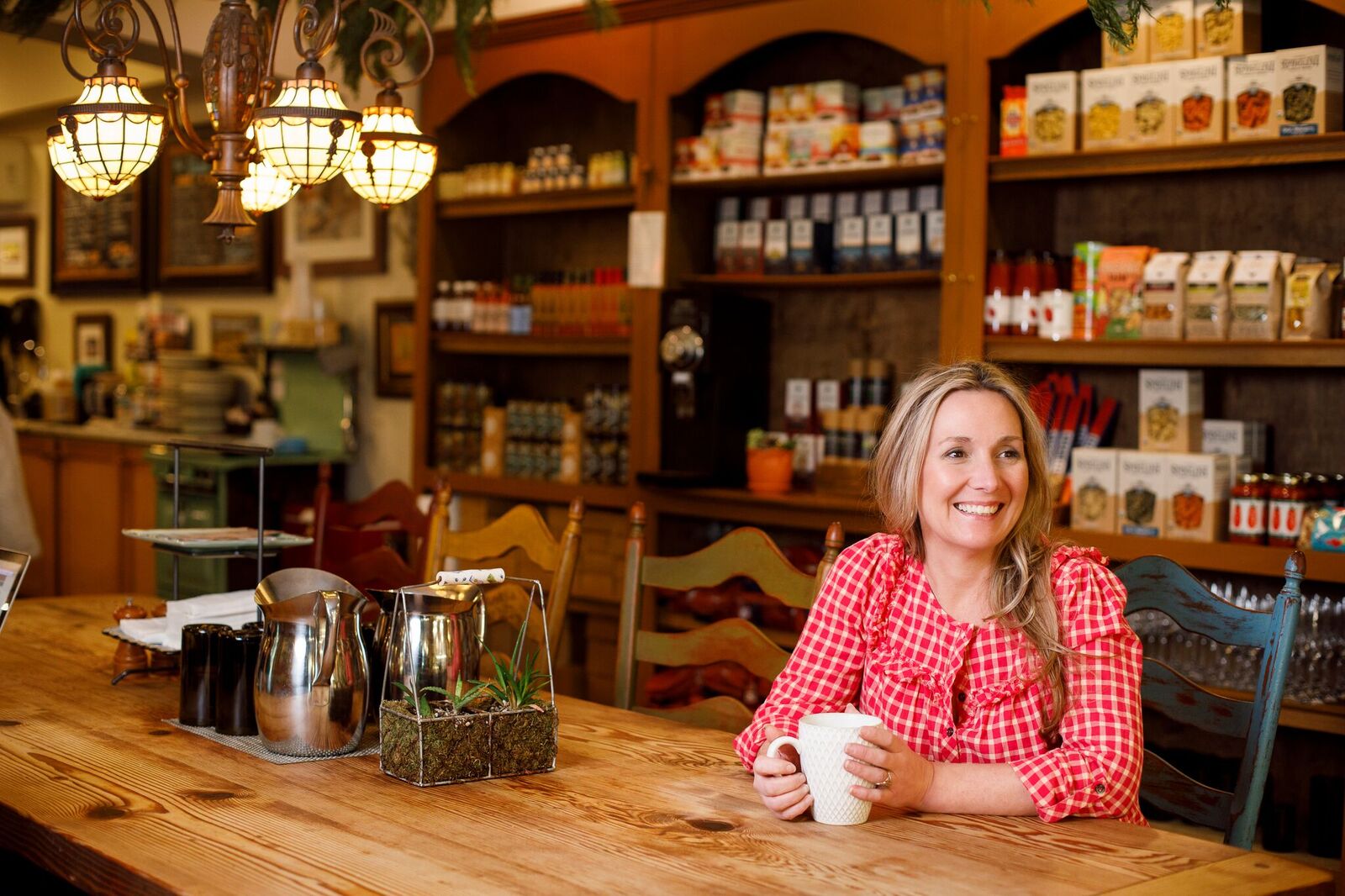 While there is no
pretense in the culinary conceptions and no
excessive stylization of the dishes, some of them
are as refined as one would have found at Le Bec
Fin back in the day. Case in point: a green
asparagus soup (above)
with whipped goat’s cheese and brioche croutons
($13) that was perfect for the season that in
another would not have had the integrity of flavor
those summer asparagus possessed.
While there is no
pretense in the culinary conceptions and no
excessive stylization of the dishes, some of them
are as refined as one would have found at Le Bec
Fin back in the day. Case in point: a green
asparagus soup (above)
with whipped goat’s cheese and brioche croutons
($13) that was perfect for the season that in
another would not have had the integrity of flavor
those summer asparagus possessed.
Like the restaurant’s name, there are a lot of
way-too-cutesy, wince-inducing descriptions on the
menu, like “Eat your veggies,” “feel good plate,”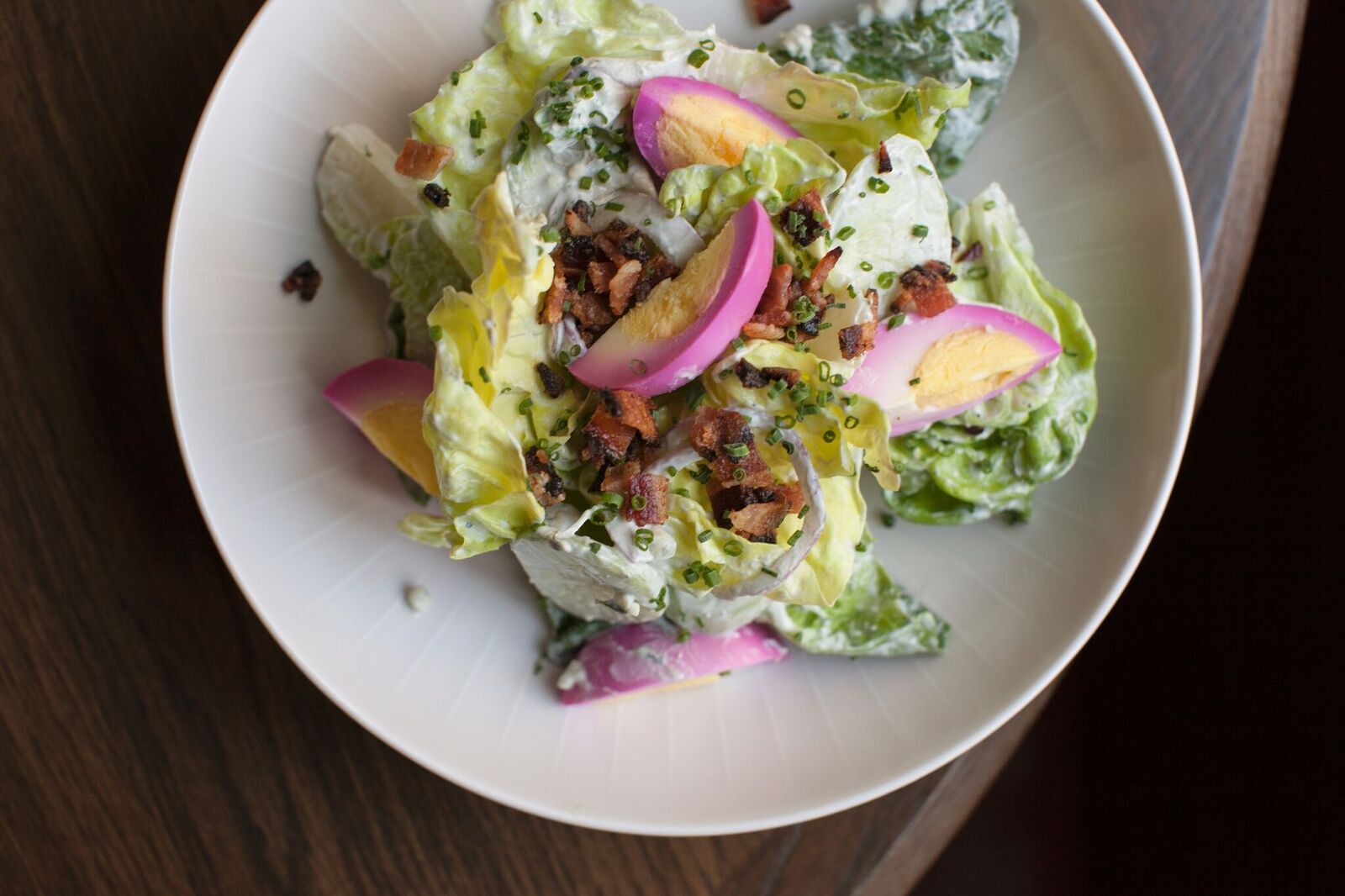 and
“turkey MMMelt,” but Olexy doesn’t mess around
with her fried catfish and hushpuppy platter with
sprout slaw ($22), as good as any you’ll find
south of Philadelphia.
and
“turkey MMMelt,” but Olexy doesn’t mess around
with her fried catfish and hushpuppy platter with
sprout slaw ($22), as good as any you’ll find
south of Philadelphia.
Crab and ricotta ravioli ($22) were delicious,
though they could have used more crab, in a rich
but light carrot sauce touched with fennel pollen. For
dessert the “dirt sundae” ($11) with chocolate
mousse, crushed cookies and cherry pâté de fruit
looked a little like potting soil but was a
terrific guilty pleasure.
The
wine list, cobbled together by Olexy and sommelier
Alexandra Cherniavsky, is sensibly laid out and
admirably inclusive, though it could use more good
bottles under $50.
Open for lunch Mon.-Fri., brunch
Sat. & Sun., dinner nightly.
❖❖❖
By John Mariani
22 E
13th Street (near
University Place)
212-
951-1082
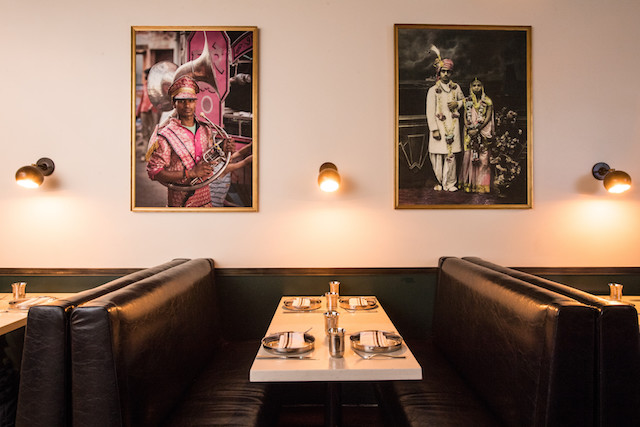
Good as they might be, most Indian
restaurants in New York lack a sense of humor.
Some, like Junoon and Tamarind Tribeca are as
elegant as their counterparts in London; others
are part of the casual Indian food cultures
around Murray Hill and in Astoria; most are
affable storefronts in just about every
neighborhood in the city. None is as much fun to
go to as Babu Ji near Union Square and N.Y.U.
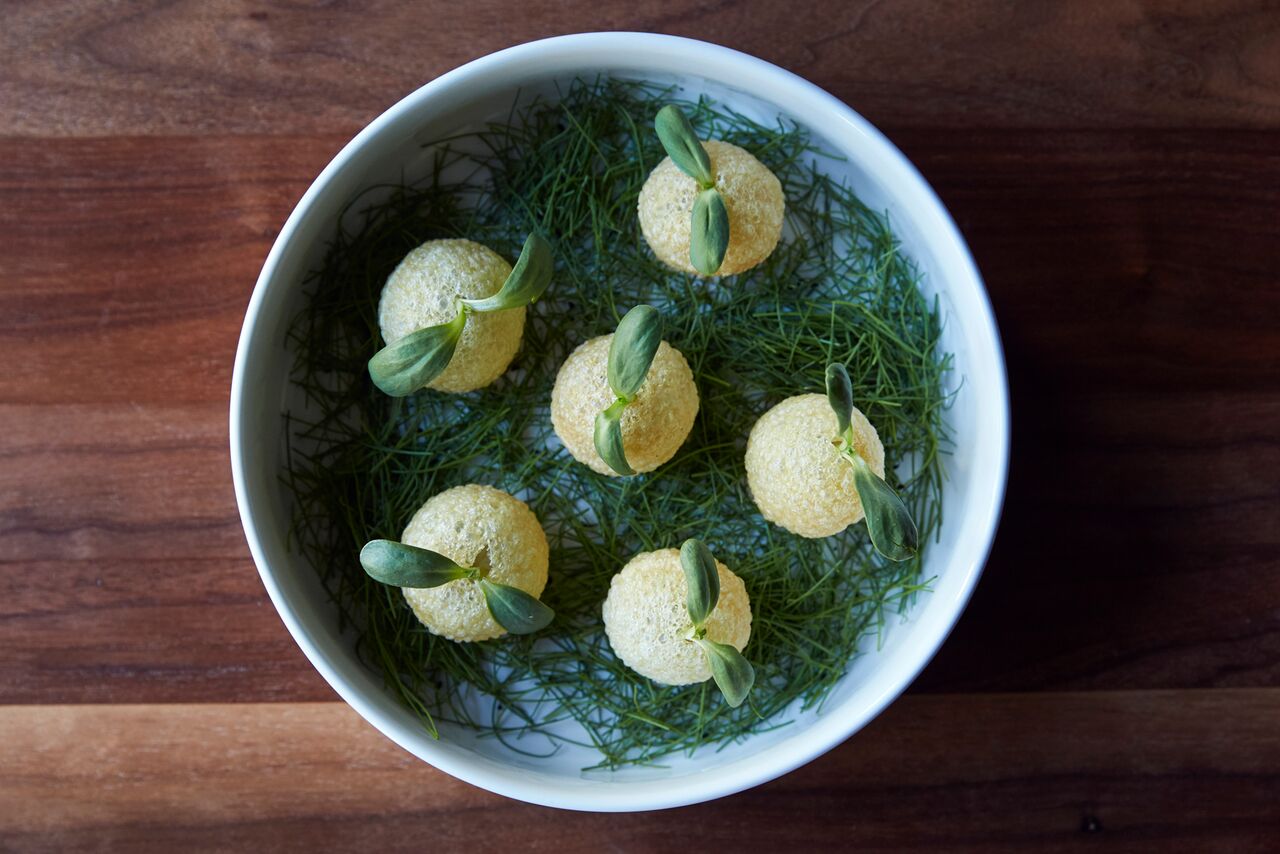 From outside you see only a bar with
a few tables, but upstairs is a two-room dining
area. The rear room is darkened and very loud but
the main section is well lighted, full of color
and the noise level not so onerous. On the white
brick walls an old Bollywood movie plays silently,
while large photos of festively dressed Indian men
and women deck out the other walls. You can even
pluck a cold beer from the refrigerator here and
bring it to your table.
From outside you see only a bar with
a few tables, but upstairs is a two-room dining
area. The rear room is darkened and very loud but
the main section is well lighted, full of color
and the noise level not so onerous. On the white
brick walls an old Bollywood movie plays silently,
while large photos of festively dressed Indian men
and women deck out the other walls. You can even
pluck a cold beer from the refrigerator here and
bring it to your table.
The party atmosphere is not accidental, for owners
Jessi and Jennifer Singh, who also run three
restaurants in Australia, named Babu Ji after an
Indian figure who functions as a “self appointed
neighborhood ambassador who knows everyone and
everything that’s happening in the village,” and
who “unashamedly indulges in food and
hospitality.”
Jessi is a self-taught chef, and his ideas about
Indian food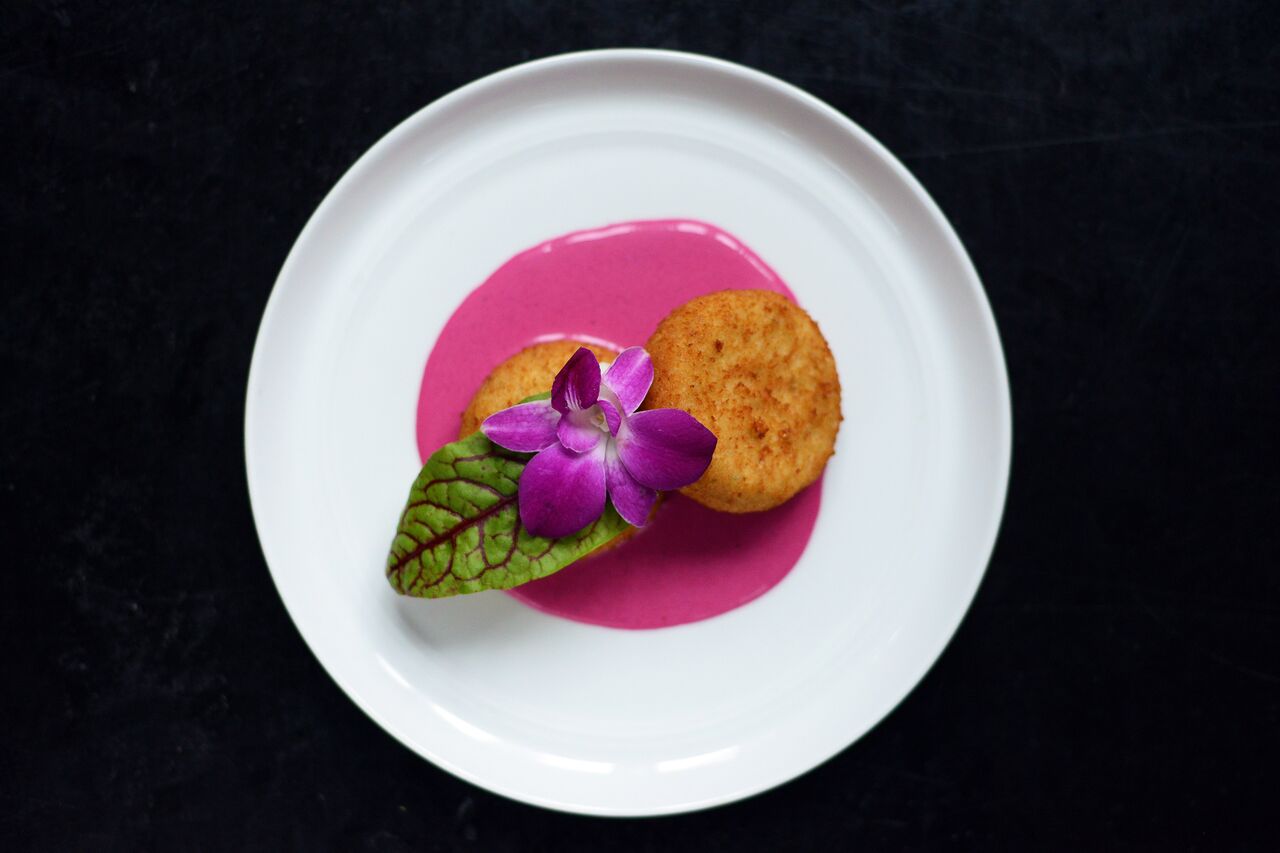 balance
many traditional dishes you’ll find around town
with some smart new concepts that are wholly his.
You might want to trust his instincts by going
with the $62 Tasting Menu, with matching beers
+$24, with wines +$34. Otherwise, go with a
foursome or more and order from all over the menu. Surprise
will co-exist with comfort food when you do.
balance
many traditional dishes you’ll find around town
with some smart new concepts that are wholly his.
You might want to trust his instincts by going
with the $62 Tasting Menu, with matching beers
+$24, with wines +$34. Otherwise, go with a
foursome or more and order from all over the menu. Surprise
will co-exist with comfort food when you do.
A
selection called “From the Street” should begin
with crisp
papadum
wafers and naan
with chutney ($16) and a pop-in-the-mouth yogurt
kebab ($15) spiced with green chili and
cardamom served over beet and ginger sauce (right).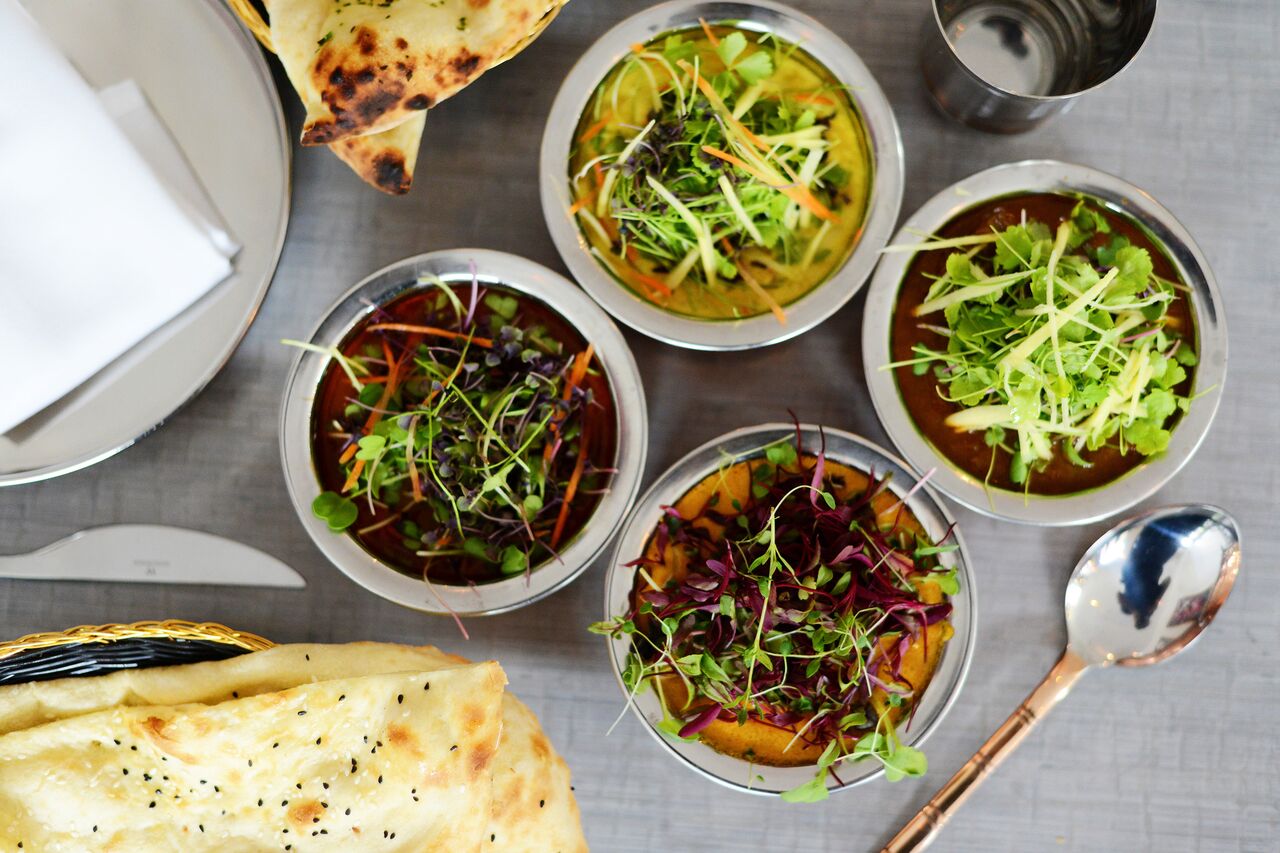
“Colonel Tso’s Cauliflower” ($16) is a play on
China’s General Tso’s chicken, here done in
Indo-Chinese style as cauliflower in a bright
tomato and chili sauce, the vegetable so tender
and aromatically seasoned. "The Original" Naan
Pizza ($16) is a further step away from
India, though it’s baked in a tandoor oven, the
fragrant steamy bread lavished with sweet-pickled
chili butter and fontina cheese.
“From the Pots” is a section that includes
“Unauthentic Butter Chicken” ($21) of
yogurt-marinated chicken, tomato, ginger, garlic
and fenugreek 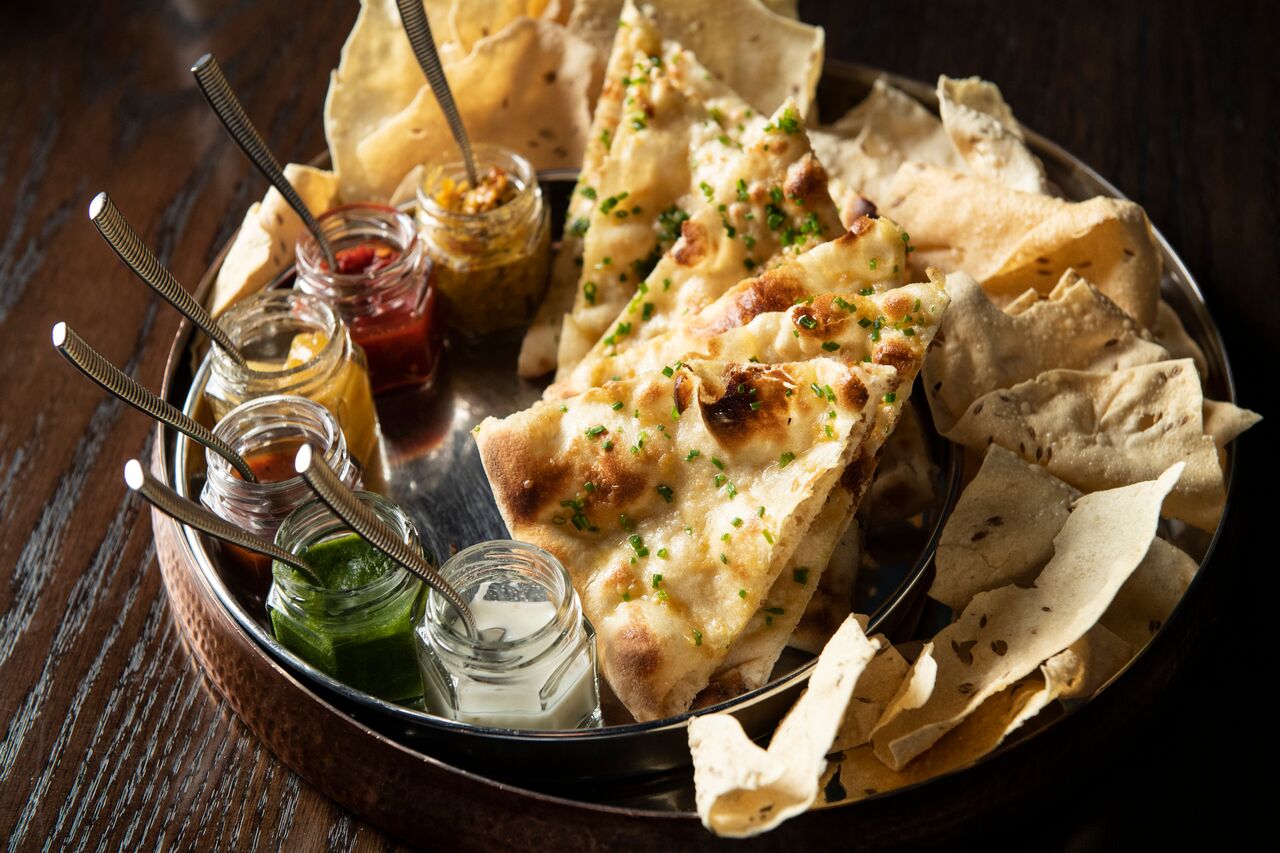 curry that has a
richness and creamy texture but not the heaviness
of some versions.
Short Rib Korma ($25) is a wondrous, hearty
plate of tender beef with fresh curry leaves,
cardamom, coriander, coconut and cashew curry,
while palak
paneer ($18)
is a cream-enriched spinach curry spiced with
cumin and chili. Lentil dals are always found on
Indian menus, and Babu Ji’s of split yellow
lentils with ginger, cumin, turmeric and coconut
milk ($14) has a freshness of flavor you don’t
always find in a dish too often left to stew on
the stove for hours.
curry that has a
richness and creamy texture but not the heaviness
of some versions.
Short Rib Korma ($25) is a wondrous, hearty
plate of tender beef with fresh curry leaves,
cardamom, coriander, coconut and cashew curry,
while palak
paneer ($18)
is a cream-enriched spinach curry spiced with
cumin and chili. Lentil dals are always found on
Indian menus, and Babu Ji’s of split yellow
lentils with ginger, cumin, turmeric and coconut
milk ($14) has a freshness of flavor you don’t
always find in a dish too often left to stew on
the stove for hours.
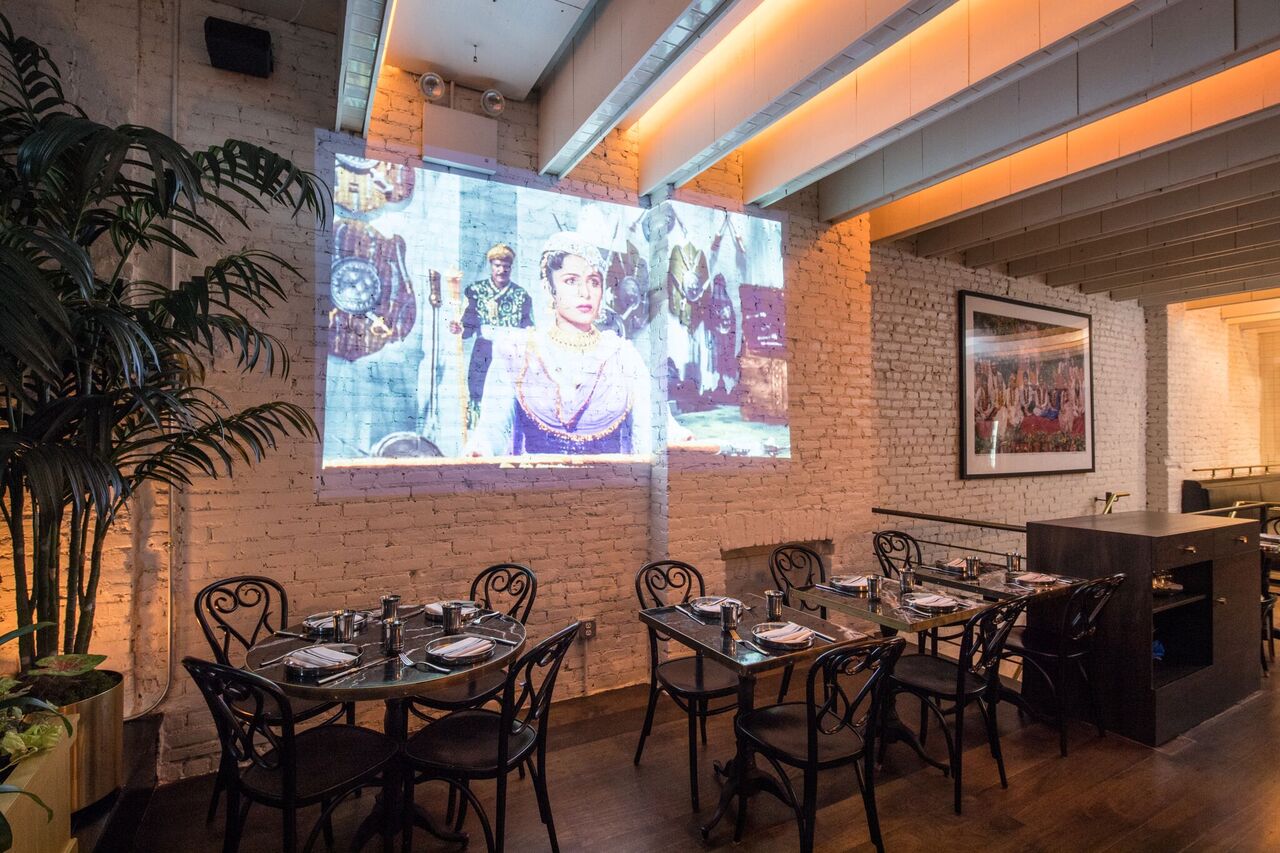 From the tandoor comes a big platter
of lamb chops ($26) with cumin-spiced
potatoes, raita yogurt and apricot chutney that
add measurably to the mild flavor of the
meat—pricey for New Zealand lamb. Indian
restaurants so often overcook their fish dishes
when done in the fiercely hot tandoor, but the
nicely charred dorade ($24) at Babu Ji was
very succulent, served with a ginger-honey sauce
and micro radish greens.
From the tandoor comes a big platter
of lamb chops ($26) with cumin-spiced
potatoes, raita yogurt and apricot chutney that
add measurably to the mild flavor of the
meat—pricey for New Zealand lamb. Indian
restaurants so often overcook their fish dishes
when done in the fiercely hot tandoor, but the
nicely charred dorade ($24) at Babu Ji was
very succulent, served with a ginger-honey sauce
and micro radish greens.
On the side you’ll want to order the aged basmati
rice ($5).
Babu Ji offers a number of Indian-spiced cocktails
($14), some that work, some that don’t.
For dessert, the one to have is a stick of kulfi
ice cream.
While writing this report, so many of the sensory
memories of the food at Babu Ji came rushing
back—especially after I’d just returned from nine
days in Spain—and Indian food of this caliber is
what I’m craving. Plus the place is a lot of fun,
if you get a less noisy table, and the service is
as affable as you’ll find in Manhattan.
Open nightly for dinner. For brunch Sat. &
Sun.
❖❖❖
FROM FRANCIACORTA
By Geoff Kalish
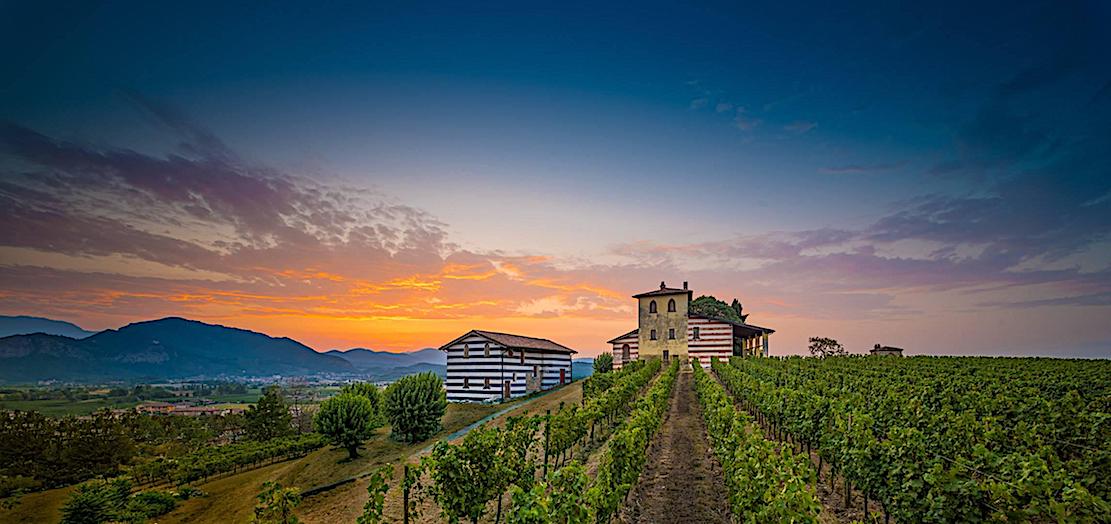
Guido Bellucchi Estate, Franciacorta
About 20 years ago
on a visit to northern Italy’s little known
Franciacorta area, I was unimpressed by the
quality and value of most of the sparklers
tasted, especially when compared with
that of the Prosecco region, only 100 miles
away.
In fact, while Franciacorta sparklers are made by
the same process as used in Champagne (i.e.,
making a base wine, then adding additional yeast
and sugar to the bottle to produce carbon dioxide
bubbles), our visit revealed many with a strange,
somewhat oxidized bouquet and a too sweet taste.
Moreover, at that time one could hardly find a
bottle of Franciacorta bubbly at more than a
handful of U.S. retail outlets.
That’s all changed. Now I’ve found that the
bouquet and taste of a number of sparklers from
Franciacorta not only outdo those of Prosecco but
rival the likes of many bottles of Champagne —and
at a very modest price when compared with that of
most bottles of Champagne. Today many more shops
nationwide are carrying more than a token brand or
two of Franciacorta sparklers.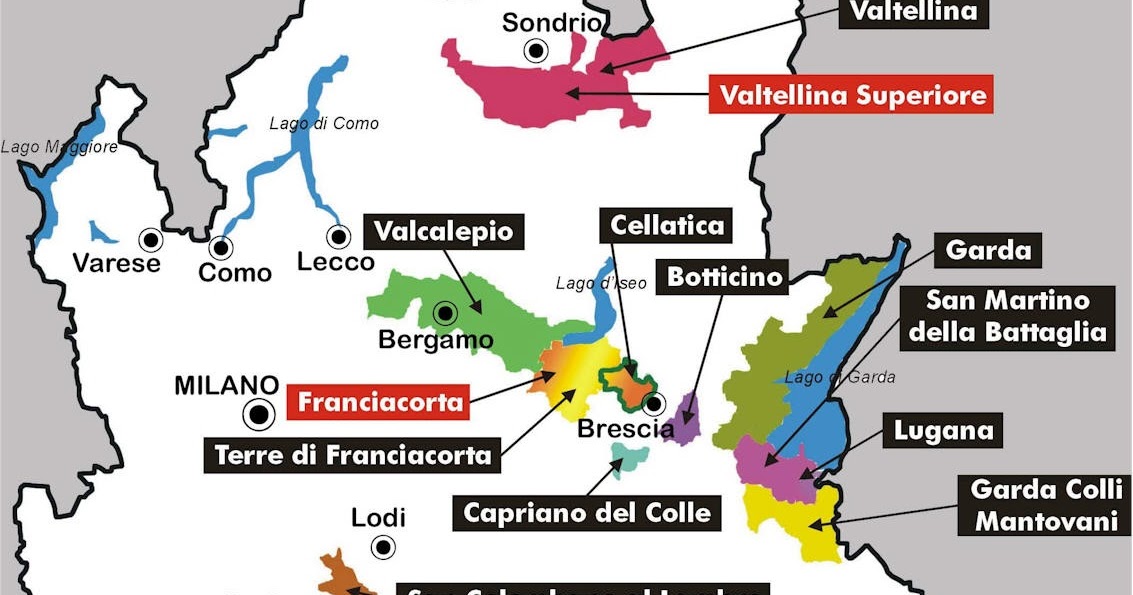
What’s accounted for this change is multifactored:
Since the late 1990s the region has witnessed an
emphasis on enhanced quality of viticultural and
vinicultural practices —especially a movement in
the region to produce the wines organically, with
the great majority now “certified” organic, as
well as an effort to determine the best growing
area for different clones of the Chardonnay and
Pinot Nero grapes (the predominant varietals used
in these wines); decreased sweetness, or even
elimination of the dosage
(the liquid that’s added to Franciacorta sparklers
when, as in the process in Champagne, the wasted
yeast from the second fermentation is removed, a
process known as “disgorgement”); and of course
some savvy marketing — the combination of which
has led to the export of over 12% of the annual
production.
To evaluate the result of the effort to enhance
the quality of these wines a tasting of 15 currently
available for consumers to purchase was conducted
at New York City’s The Leopard des Artistes by the
Wine Media Guild (a U.S.-based organization of
professional wine communicators). To be honest, I
didn’t love every one of those tasted, finding a
few too sweet and others not rising above the
quality of good Prosecco. On the other hand, I
found a number of the wines outstanding, and the
following are my notes on these with my top choice
in each of 7 categories.
ZERO
DOSAGE
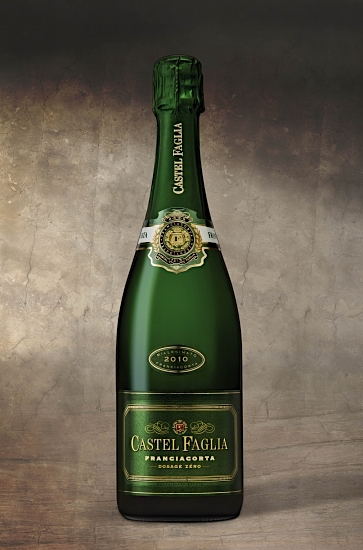 Castel Faglia, Dosaggio
Zero, Millesimato 2012 ($23)
Castel Faglia, Dosaggio
Zero, Millesimato 2012 ($23)
This
sparkler is made of 90% Chardonnay and 10% Pinot
Nero grapes and, as the name implies, no
additional sugar is added to the wine when it’s
disgorged. It shows a straw yellow color, a steady
stream of rapidly rising bubbles and a delicate,
fruity taste with hints of almonds and cinnamon in
its dry finish.
EXTRA
BRUT
Il Mosnel, Extra
Brut. Vintage 2013 ($52)
Made
from 100% Chardonnay grapes, this wine was
fermented in small oak casks over five months with
the second fermentation taking place over 3 years.
It has a pale yellow color, very fine bubbles and
a refreshing bouquet and taste, with hints of
vanilla in its finish. One might be hard pressed
to distinguish this wine from a top-tier
Champagne.
NON-VINTAGE
BRUT
Ca Del Bosco, Cuvee
Prestige, Brut NV ($32)
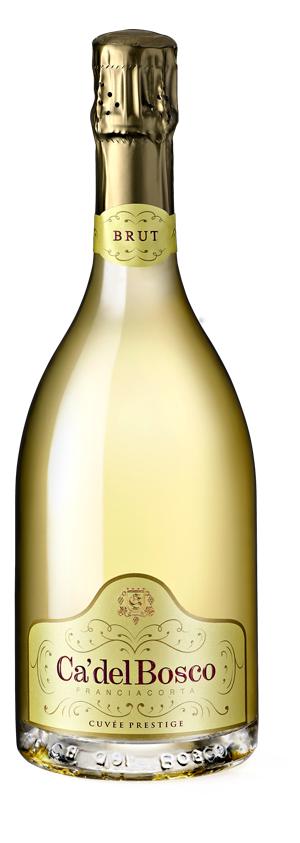
This
bubbly is made from 75% Chardonnay, 10% Pinot
Bianco and 15% Pinot Nero grapes. Fermentation
took place in temperature-controlled
stainless-steel tanks over five months. In making
the final blend, a small amount of “reserve”
wine from other vintages was added, with the
second fermentation taking place over 25 months.
Of note, disgorgement takes place in an
oxygen-free atmosphere, so that very little sulfur
dioxide needs to be added. It shows a bouquet and
taste of peaches and brioche and has a very fruity
finish with a bit of vibrant acidity.
VINTAGE
BRUT
Franciacorta,
Bellavista,
Millesimato, Brut Vintage 2012 ($45)
Made
from 73% Chardonnay and 27% Pinot Nero, this
outstanding sparkler underwent primarily
stainless-steel tank fermentation, with 30% of the
grapes barrel fermented. The second fermentation
was conducted over 36 months. It shows a pale
straw color and a fine stream of bubbles, with
aromas and an elegant taste of ripe apples and
brioche, with a
long memorable finish, that has notes of
almonds and vanilla.
SATĖN (A
classification unique to the area in which the
blend must be made from only white grapes and have
a bottle pressure so as to produce a very “foamy”
wine.)
Ricci Curbastro,
Saten Millesimato NV, Dossagio Zero ($49)
This 100% Chardonnay
wine was fermented in oak and underwent its second
fermentation over 48 months. It has a straw yellow
color, a bouquet and creamy taste of apples and
peaches with hints of fennel and lemon in its
smooth finish. This wine makes an excellent mate
for grilled salmon, veal or smoky cheeses.
ROSÉ
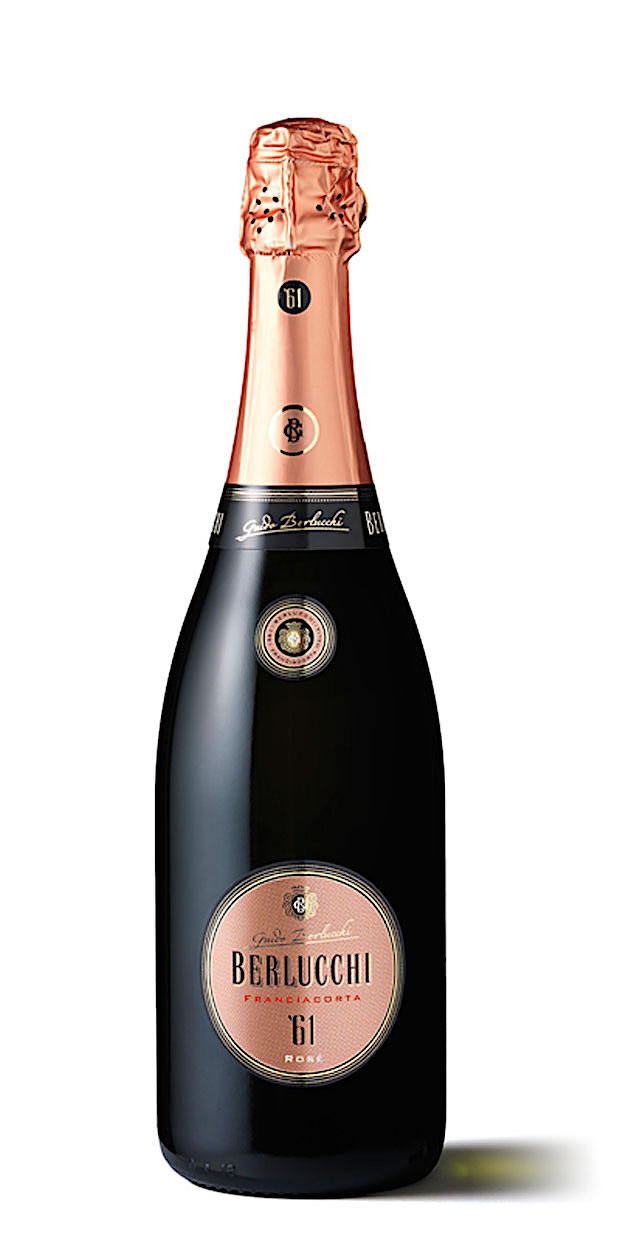
Guido
Berlucchi, Rosé NV ($29)
Made
from 60% Pinot Nero and 40% Chardonnay, this great
value from the producer who first made sparkling
wines in the area shows a fragrant bouquet and
taste of ripe cherries and strawberries, with
hints of lemons and limes in its finish. More than
just an aperitif wine, it makes great
accompaniment to pasta with red sauce as well as
grilled branzino or shrimps.
BLANC
DE NOIR
Majolini, Blanc de
Noir, Brut NV ($56)
While
a bit pricey, this 100% Pinot Noir wine, from
grapes hand harvested from a vineyard on a hilltop
loaded with calcareous soil, represents Pinot Noir
bubbly at its best, with fragrant flavors of ripe
berries and a taste of berries and hints of dried
apricots in its long smooth finish. This is an
ideal wine to mate with a wide range of food from
scallops to grilled chicken or veal.
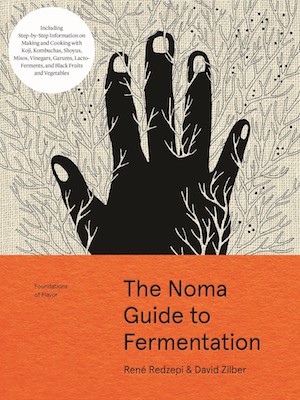
WE CAN HARDLY WAIT TO DIG IN!
By René Redzepi
and David Zilber
THEY'RE NOW
THINKING OF PIT BULL FRIDAYS
A Carrabba’s Italian Grill in Stuart, FL, ended its
Monkey Mondays after a 9-month-old capuchin monkey bit
someone. The weekly tradition surrounded a pair
of monkey owners — Mary and Richard Van Houten — who
brought at least one of their five pet monkeys in each
week to the restaurant.
❖❖❖
Wine
Column Sponsored by Banfi Vintners
SANGIOVESE
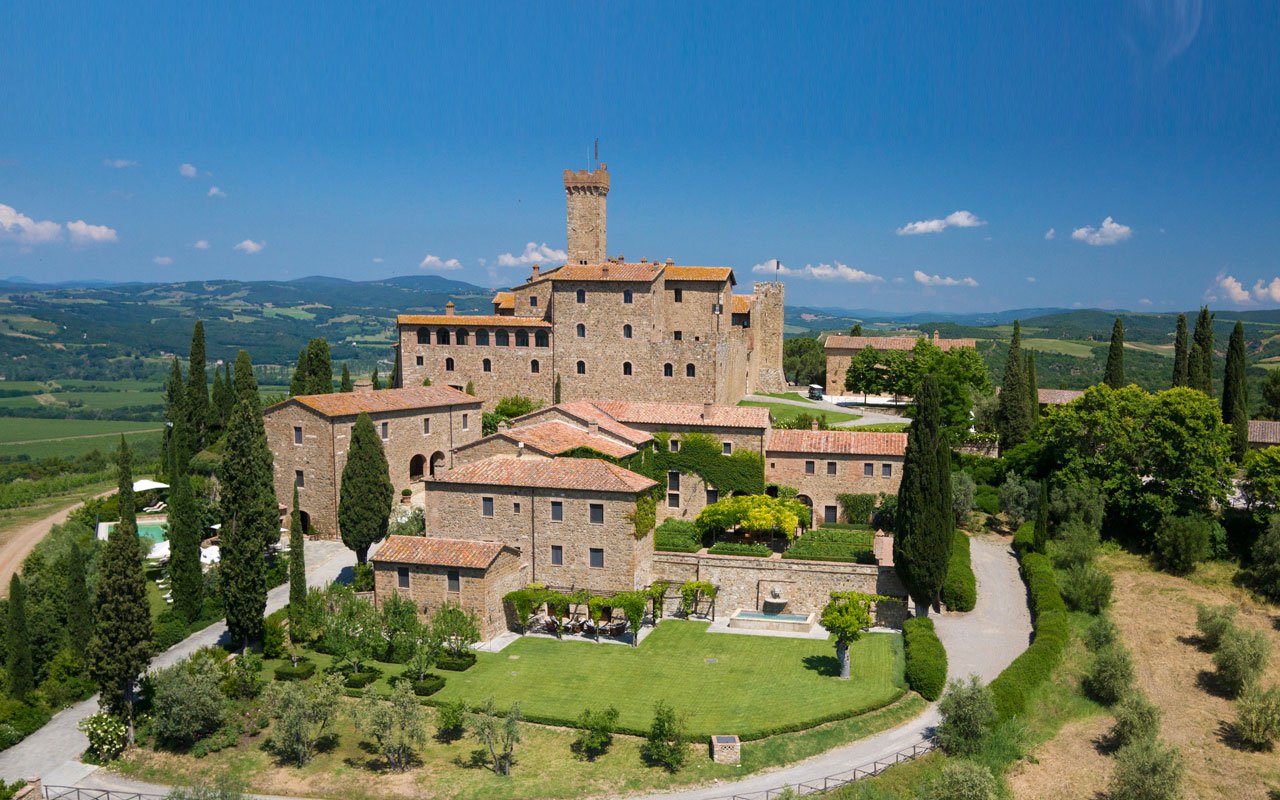 Wine is a joy year-round but
in cooler weather one
grape varietal has really taken center stage in
my daily activities – that most Italian of
grapes, Sangiovese, and its ultimate expression
– Brunello di Montalcino.
Wine is a joy year-round but
in cooler weather one
grape varietal has really taken center stage in
my daily activities – that most Italian of
grapes, Sangiovese, and its ultimate expression
– Brunello di Montalcino.
From mid-September through mid-October,
the Sangiovese grown for our various styles of red
wines are be harvested, culminating with the top
selection for Brunello di Montalcino.
Second, cooler weather here means
it is time to start enjoying more red wines and
especially Sangiovese based wines. That
includes Banfi’s cru of Brunello, Poggio alle Mura,
literally the cream of the crop of our Sangiovese
vineyards. Alongside our Poggio alle Mura Brunello di
Montalcino, this year we introduced two more wines
from the cru Poggio alle Mura – a Rosso di Montalcino
and a Riserva of Brunello. Rosso is sort of like the
younger brother of Brunello, also made from 100%
Sangiovese grapes but usually a selection from younger
vines and the wine is aged only two years compared to
the four required for Brunello. The
Riserva, on the other hand, is an even more selective
harvest of Sangiovese, and ages for an additional year
before release.
What is so special about this cru
Poggio alle Mura?
Well, it is the result our over 30 years of
ongoing research at my family’s vineyard estate,
Castello Banfi.
When we first began planting our vines there in
the late 1970s studies from the University of Bordeaux
indicated which strains of many varietals we should
plant, based on the soil type and microclimate of each
vineyard. But
when it came to the region’s native Sangiovese, there
was only local lore, no scientific research. So we took
it upon ourselves to figure out this vine, and set off
on three decades of incredibly detailed research.
We started
with 600 apparent variations on Sangiovese, because it
is so susceptible to variations in weather and soil,
and narrowed that down to 160 truly genetically
different clones.
We planted a vineyard with two rows of each
type, made wine from each of them, and charted the
differences – remember, you only get one chance a year
to make wine, so this took time.
It took about ten years to get some
concrete results, though we continue to experiment
today and always will – you never stop learning in
science and nature!
Once we determined which were the best,
complementary clones that could be planted together to
make the best Brunello, we chose to plant them in what
we determined to be the optimal vineyard sites. Coincidentally,
the best soils and climate conditions are in the
slopes surrounding the medieval fortress today known
as Castello Banfi, known since Etruscan times as
Poggio alle Mura – the walled hilltop. Hence the
name of our most special “cru” of Brunello,
representing a synthesis between tradition and
innovation.
Though the focus of this study was
our Brunello, all of our Sangiovese-based wines,
including the super Tuscans SummuS, Cum Laude, and
Centine, benefitted from this work. And that’s
the third reason for celebrating Sangiovese this
month, for the range of wonderful reds that usher us
into autumn! One
wine in particular was inspired by our research – the
BelnerO, a Sangiovese dominant blend with what I like
to call a kiss of Cabernet and a whisper of Merlot. We grow the
grapes a little differently for BelnerO than for
Brunello, make the wine with less oak aging and
released it earlier from the winery, providing a
counterpoint to Brunello and a lovely terroir-driven
wine in its own right.
If you
know Italians, you know that by nature we are
multi-faceted, varying in mood, and always passionate. As a
nation, we span from the hot sunny beaches of Sicily
near the African coast to the rugged mountains and
Alpine ski slopes of Trentino-Alto Adige in the north. Sangiovese
is grown in almost all of Italy’s regions and reflects
the unique nature of each; it is most famous
(rightfully so) in Tuscany, yet even there it reflects
the nuances of each hilltop, valley and subzone. It has
something a little different to say in Brunello than
Chianti, Morellino than Vino Nobile di Montepulciano,
Rosso di Montalcino than Super Tuscan blends.
Here is a smattering of
Sangiovese-based wines that you may wish to get to
know better, reflecting a spectrum that appeals to
every occasion, every taste, and every budget. We can
assure you that the conversation will never become
boring. 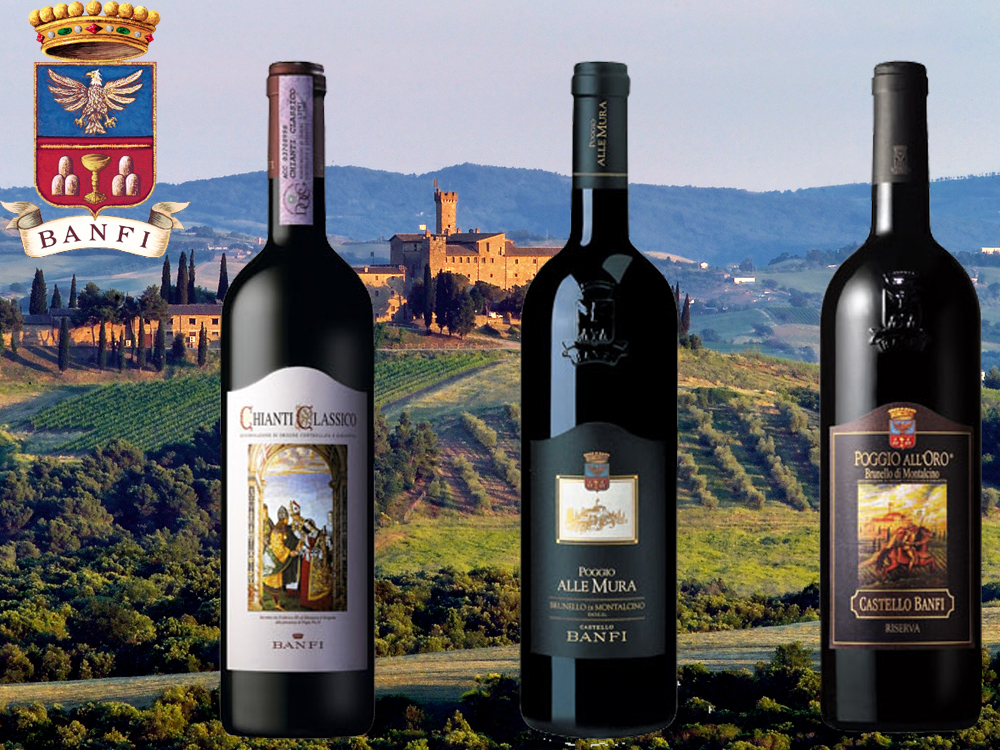
Recommendations for Celebrating
Sangiovese
BelnerO Proprietor’s Reserve Sangiovese
– A refined
cuvée of noble red grapes perfected by our pioneering
clonal research. This dark beauty, BelnerO, is
produced at our innovative winery, chosen 11
consecutive years as Italy’s Premier Vineyard Estate.
Fermented in our patented temperature controlled
French oak and aged approximately 2 additional years.
Unfiltered, and Nitrogen bottled to minimize sulfites.
Castello Banfi Brunello di Montalcino –
Rich, round, velvety and intensely
aromatic, with flavor hints of licorice, cherry, and
spices. Brunello di Montalcino possesses an intense
ruby-red color, and a depth, complexity and opulence
that is softened by an elegant, lingering aftertaste.
Unfiltered after 1998 vintage.
Castello Banfi Rosso di Montalcino – Brunello's "younger brother," produced
from select Sangiovese grapes and aged in barrique for
10 to 12 months. Deep ruby-red, elegant, vibrant,
well-balanced and stylish with a dry velvety
finish.
Poggio all’Oro Brunello di Montalcino
Riserva – A single vineyard selection of our most
historically outstanding Sangiovese, aged five years
before release, the additional year more than that
required of Brunello including 6 months in barrel and
6 months more in bottle to grant its “Riserva”
designation. Incredible
elegance and harmony. Intense with lots of fruit and
subtle wood influence. Round, complete, well balanced
with hints of chocolate and berries. Unfiltered after
1998.
Poggio alle Mura – The first tangible result of years of
intensive clonal research on Montalcino’s native
Sangiovese grape.
Estate bottled from the splendidly sun drenched
vineyards surrounding the medieval Castello from which
it takes its name.
The Brunello
di Montalcino is seductive, silky and smoky. Deep ruby
in color with an expressive bouquet of violets, fruits
and berries as well as cigar box, cedar and exotic
spices. The Rosso
di Montalcino is also intense ruby red. The bouquet
is fresh and fruity with typical varietal notes of
cherry and blackberry, enriched by more complex hints
of licorice, tobacco and hazelnut. It is full
bodied, yet with a soft structure, and a surprisingly
long finish. The Poggio alle Mura Brunello di Montalcino
Riserva is deep ruby red with garnet
reflections and a rich, ample bouquet that hints of
prune jam, coffee, cacao and a light balsamic note. It is full
and powerful, with ripe and gentle tannins that make
it velvety and harmonious; this wine is supported by a
pleasing minerality that to me speaks soundly of that
special hillside in southern Montalcino.
SummuS – A wine of towering elegance, SummuS is an
extraordinary blend of Sangiovese which contributes
body; Cabernet Sauvignon for fruit and structure; and
Syrah for elegance, character and a fruity bouquet. An elegant,
complex and harmonious red wine.
Cum Laude – A complex and elegant red which graduated
“With Honors,” characterized by aromas of juicy
berries and fresh spices.
Centine – A Cuvee that is more than half
Sangiovese, the balanced consisting of equal parts of
Cabernet Sauvignon and Merlot. Vinified in
a firm, round style that easily accompanies a wide
range of dishes, this is a smooth and fragrantly
satisfying wine with international character, and a
perennial favorite at my own dinner table.
Banfi Chianti Superiore – The “Superiore” designation signifies
stricter government regulations regarding production
and aging requirements, as compared to regular
Chianti. An
intense ruby red wine with fruit forward aromas and
floral notes. This
is a round wine with well-balanced acidity and fruit.
Banfi Chianti Classico – An enduring classic: alluring
bouquet of black fruit and violets; rich flavors of
cherry and leather; supple tannins and good acidity
for dining.
Banfi Chianti Classico Riserva – Produced from select grapes grown in the
"Classico" region of Chianti, this dry, fruity and
well-balanced red has a full bouquet reminiscent of
violets.
Fonte alla Selva Chianti Classico – This is our newest entry into the Chianti
arena, coming from a 99 acre estate in Castellina, the
heart of the Chianti Classico region. The wine is
a captivating mauve red that smells of cherry, plum
and blackberry with hints of spice. It is
round, full and balanced with very good
acidity.
Col di Sasso – Sangiovese and Cabernet Sauvignon. Luscious,
complex and soft with persistent notes of fruit and
great Italian style structure.
Any of John Mariani's books below may be ordered from amazon.com.
 The Hound in Heaven
(21st Century Lion Books) is a novella, and
for anyone who loves dogs, Christmas, romance,
inspiration, even the supernatural, I hope you'll find
this to be a treasured favorite. The story
concerns how, after a New England teacher, his wife and
their two daughters adopt a stray puppy found in their
barn in northern Maine, their lives seem full of promise.
But when tragedy strikes, their wonderful dog Lazarus and
the spirit of Christmas are the only things that may bring
his master back from the edge of despair.
The Hound in Heaven
(21st Century Lion Books) is a novella, and
for anyone who loves dogs, Christmas, romance,
inspiration, even the supernatural, I hope you'll find
this to be a treasured favorite. The story
concerns how, after a New England teacher, his wife and
their two daughters adopt a stray puppy found in their
barn in northern Maine, their lives seem full of promise.
But when tragedy strikes, their wonderful dog Lazarus and
the spirit of Christmas are the only things that may bring
his master back from the edge of despair. WATCH THE VIDEO!
“What a huge surprise turn this story took! I was completely stunned! I truly enjoyed this book and its message.” – Actress Ali MacGraw
“He had me at Page One. The amount of heart, human insight, soul searching, and deft literary strength that John Mariani pours into this airtight novella is vertigo-inducing. Perhaps ‘wow’ would be the best comment.” – James Dalessandro, author of Bohemian Heart and 1906.
“John Mariani’s Hound in Heaven starts with a well-painted portrayal of an American family, along with the requisite dog. A surprise event flips the action of the novel and captures us for a voyage leading to a hopeful and heart-warming message. A page turning, one sitting read, it’s the perfect antidote for the winter and promotion of holiday celebration.” – Ann Pearlman, author of The Christmas Cookie Club and A Gift for my Sister.
“John Mariani’s concise, achingly beautiful novella pulls a literary rabbit out of a hat – a mash-up of the cosmic and the intimate, the tragic and the heart-warming – a Christmas tale for all ages, and all faiths. Read it to your children, read it to yourself… but read it. Early and often. Highly recommended.” – Jay Bonansinga, New York Times bestselling author of Pinkerton’s War, The Sinking of The Eastland, and The Walking Dead: The Road To Woodbury.
“Amazing things happen when you open your heart to an animal. The Hound in Heaven delivers a powerful story of healing that is forged in the spiritual relationship between a man and his best friend. The book brings a message of hope that can enrich our images of family, love, and loss.” – Dr. Barbara Royal, author of The Royal Treatment.
 |
The Encyclopedia of American Food and Drink by John F. Mariani (Bloomsbury USA, $35) Modesty forbids me to praise my own new book, but let me proudly say that it is an extensive revision of the 4th edition that appeared more than a decade ago, before locavores, molecular cuisine, modernist cuisine, the Food Network and so much more, now included. Word origins have been completely updated, as have per capita consumption and production stats. Most important, for the first time since publication in the 1980s, the book includes more than 100 biographies of Americans who have changed the way we cook, eat and drink -- from Fannie Farmer and Julia Child to Robert Mondavi and Thomas Keller. "This book is amazing! It has entries for everything from `abalone' to `zwieback,' plus more than 500 recipes for classic American dishes and drinks."--Devra First, The Boston Globe. "Much needed in any kitchen library."--Bon Appetit. |
"Eating Italian will never be the same after reading John Mariani's entertaining and savory gastronomical history of the cuisine of Italy and how it won over appetites worldwide. . . . This book is such a tasteful narrative that it will literally make you hungry for Italian food and arouse your appetite for gastronomical history."--Don Oldenburg, USA Today. "Italian
restaurants--some good, some glitzy--far
outnumber their French rivals. Many of
these establishments are zestfully described
in How Italian Food Conquered the World, an
entertaining and fact-filled chronicle by
food-and-wine correspondent John F.
Mariani."--Aram Bakshian Jr., Wall Street
Journal.
"Equal parts
history, sociology, gastronomy, and just
plain fun, How Italian Food Conquered the
World tells the captivating and delicious
story of the (let's face it) everybody's
favorite cuisine with clarity, verve and
more than one surprise."--Colman Andrews,
editorial director of The Daily
Meal.com. "A fantastic and fascinating
read, covering everything from the influence
of Venice's spice trade to the impact of
Italian immigrants in America and the
evolution of alta cucina. This book will
serve as a terrific resource to anyone
interested in the real story of Italian
food."--Mary Ann Esposito, host of PBS-TV's
Ciao
Italia. "John Mariani has written the
definitive history of how Italians won their
way into our hearts, minds, and
stomachs. It's a story of pleasure over
pomp and taste over technique."--Danny Meyer,
owner of NYC restaurants Union Square
Cafe, The Modern, and Maialino.
|
 |
 |
 |
 |
 |
 |
 |
 |
 Everett Potter's Travel Report:
Everett Potter's Travel Report: 
 Eating Las Vegas
JOHN CURTAS has been covering the Las Vegas
food and restaurant scene since 1995. He is
the co-author of EATING LAS VEGAS – The 50
Essential Restaurants (as well as
the author of the Eating Las Vegas web site: www.eatinglasvegas.
He can also be seen every Friday morning as
the “resident foodie” for Wake Up With the
Wagners on KSNV TV (NBC) Channel 3 in
Las Vegas.
Eating Las Vegas
JOHN CURTAS has been covering the Las Vegas
food and restaurant scene since 1995. He is
the co-author of EATING LAS VEGAS – The 50
Essential Restaurants (as well as
the author of the Eating Las Vegas web site: www.eatinglasvegas.
He can also be seen every Friday morning as
the “resident foodie” for Wake Up With the
Wagners on KSNV TV (NBC) Channel 3 in
Las Vegas.
MARIANI'S VIRTUAL GOURMET
NEWSLETTER is published weekly. Publisher: John Mariani. Editor: Walter Bagley. Contributing Writers: Christopher Mariani,
Robert Mariani, Misha Mariani, John A. Curtas, Gerry Dawes, Geoff Kalish,
and Brian Freedman. Contributing
Photographer: Galina Dargery. Technical
Advisor: Gerry
McLoughlin.
If you wish to subscribe to this
newsletter, please click here: http://www.johnmariani.com/subscribe/index.html
© copyright John Mariani 2017

